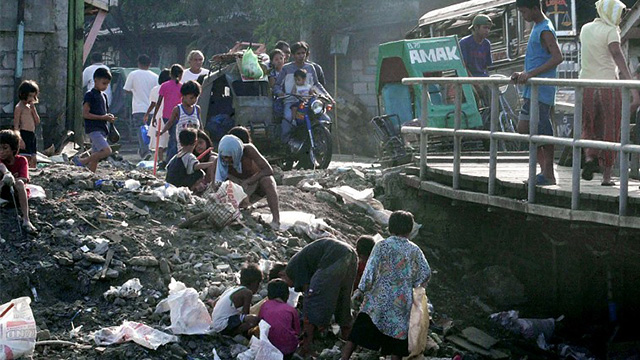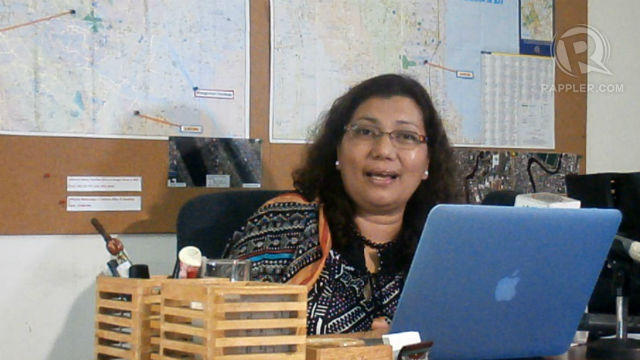SUMMARY
This is AI generated summarization, which may have errors. For context, always refer to the full article.

MANILA, Philippines – The relocation of informal settler families (ISF) is not a violation of human rights, National Anti-Poverty Commission (NAPC) assistant secretary Gina Cantano-Dela Cruz said Friday, June 28.
This was in reaction to some claims by youth groups that the relocation of ISF in Metro Manila was a “crime against humanity.”
In a press conference Friday, Dela Cruz said that the relocation plans were intended to save lives.
“Ang pagtanaw po natin…yung tinatawag nating human rights-based approach…Kinakailangan naman nilang maalis sa danger zone,” Dela Cruz said. (We use the human rights-based aproach. The ISFs need to be taken out of danger zones.)
Dela cruz maintained that consultations were held for the planned relocation of over 104,000 ISFs.
“Ang hindi po talaga acceptable kung basta sila ililipat na walang konsultasyon. At tinitiyak naman po…ang ating pamahalaan ngayon…ang sistema po niya ay mataas ang regard sa karapatang pantao,” she added.
(What’s not acceptable is to relocate them without consultation. We assure you that the current government has a high regard for human rights.)
Grassroots approach

Dela Cruz maintained that the government’s relocation plans are based on the appeal of communities.
“Kapag tinanong niyo po ang mga urban poor, gusto nilang maalis talaga diyan at sila po ay nakahanda. In fact, nag-submit na sila ng plano nila,” she added. (The urban poor want to be relocated if you ask them. In fact, they already submitted their plans.)
The NAPC collected People’s Plans (PPs) from the different ISF communities and other non-governmental organizations. The plans include research results and proposals for the relocation and resettlement of the communities.
Part of the plans were specific locations where the communities requested to be moved. Relocation areas were categorized as in-city, on-site and off-city.
Dela Cruz maintained that the relocation areas were considered based on the ISFs’ livelihood and needs.
“Ang mahalaga po dito, paano hindi masyadong maapektuhan yung kanilang trabaho, yung kanilang pamilya, yung pag-aaral ng mga anak. ‘Yun po talaga ang dahilan kung bakit…sa strategy na nilatag…mas maganda na on-site and in-city,” she added.
(We make sure that the parent’s jobs, the family livelihoods and the children’s education will not be affected. That is why many will be relocated to on-site and in-city areas.)
According to Dela Cruz, the NAPC already received 25 People’s Plans covering at least 30,000 ISFs. They are expecting 26 more.
Despite the good PPs, however, Dela Cruz admitted that close coordination between government agencies is crucial to success.
“The People’s Plans potential for success is huge but hinges on the response time and collective efforts of the government bureaucracy,” she added.
No ‘crimes against humanity’
On June 25, Anakbayan, Kabataan party list, and other youth groups rallied in front of the Department of the Interior and Local Government (DILG) protesting against what they claimed to be the “all-out demolition” of Metro Manila ISFs. (Read: Youth activists to PNoy: Stop ‘estero’ demolitons)
The protesters called the planned demolitions a crime against humanity, citing the Rome Statute of the International Criminal Court.
The militant youth groups were particularly concerned with the P18,000 rental subsidy offered by the government to ISFs. They said the subsidy is “useless” if the families lose their sources of income.
Dela Cruz maintained, however, that the subsidy is only the initial help to be given to ISFs.
“Ang subsidy kung wala nang iba pa, ay hindi talaga sustainable. Pero sabi nga ni Sec. Dink Soliman, ang P18,000 ay on top ng iba pang ginagawa…ng government agencies,” Dela Cruz said.
(The subsidy alone is not sustainable. But as secretary Dinky Soliman said, the P18,000 is only the top of what other government agencies are doing.)
She added that the Department of Social Welfare and Development (DSWD) already has follow-up plans for the communities once the relocations are done.
“Kinakailangan din na masundan ng mga agencies para mai-transfer ang lahat ng kanilang mga inaasahan na social welfare sa LGU…May eskuwelahan ba doon? Kumusta yung trabaho nila? Meron bang bubuksan doon na livelihood project ang LGU?” Dela Cruz said.
(The government agencies will make sure that the basic social welfare services for the ISFs will be transferred to the local government units (LGU). Are there schools there? How are their work? Will the LGU open livelihood projects?)
She maintained that the relocation plans were from President Benigno Aquino III’s marching orders to have zero casualty when typhoons strike Metro Manila.
According to Dela Cruz, the NAPC targets to have 4,000 ISFs relocated by the 31st of July. These are part of the 19,000 families living in the most vulnerable areas that are prioritized by the NAPC. -Rappler.com
Add a comment
How does this make you feel?
There are no comments yet. Add your comment to start the conversation.